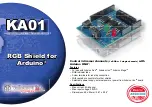SECURITY
STATUS
NXP Semiconductors
JN-RM-2080
K32W module development reference manual
JN-RM-2080
All information provided in this document is subject to legal disclaimers.
© NXP Semiconductors N.V. 2020. All rights reserved.
Reference manual
Rev. 1.0
— 27 Mar 2020
9 of 30
Contact information
For more information, please visit:
thickness of the dielectric substrate under the transmission line will have a significant
change in impedance; all this information can be found on the fabrication notes for
each board design. As an illustration, consider a 50-ohm microstrip trace that is 18-mils
wide over 10 mils of FR4. If that thickness of FR4 is changed from 10 to 6 mils, the
impedance will only be about 36 ohms.
In any case the width of the RF lines must be re-calculated according to the PCB
characteristics in order to ensure a 50-ohm characteristic impedance.
When the top layer dielectric becomes too thin, the layers will not act as a true
transmission line, even though all the dimensions are correct. There is not universal
industry agreement on which thickness at which this occurs, but NXP prefers to use a
top layer dielectric thickness of no less than 8-10 mils.
There is also a limit to the ability of PCB fabricators to control the minimum width of a
PCB trace and the minimum thickness of a dielectric layer. +/- 1 mil will have less
impact on an 18-mils wide trace and a 10-mil thick dielectric layer, than it will on a much
narrower trace and thinner top layer.
This can be an especially insidious problem. The design will appear to be optimized
with the limited quantity of prototype and initial production boards, in which the bare
PCB's were all fabricated in the same lot. However, when the product goes into mass
production there can be variations in PCB fabrication from lot-to-lot which can degrade
performance.
The use of a correct substrate like the FR4 with a dielectric constant of 4.4 will assist you
in achieving a good RF design.
While no special measures are required for the board design, it is recommended that
Class 1 tolerances be used.
4.3 RF circuit topology and matching
NXP always recommends that designers start by copying the existing NXP reference
design. This applies to both the circuit portion (schematic) of the design, and the PCB
layout. For all RF designs, particularly for designs at frequencies as high as 2.4 GHz,
the PCB traces are a part of the design itself. Even a very short trace has a small
amount of parasitic impedance (usually inductive), which has to be compensated for in
the remainder of the circuit.
What may seem like a minor change to the layout, or what would certainly be a minor
change at a lower frequency of operation, can actually be a significant change at 2.4
GHz. For example, we may consider that a metal trace on a PCB such as the K32W061-
001M1x modules is approximately 0.8 nH per mm. At lower frequencies, this would have
no impact, but at 2.4 GHz this would have a significant impact in any matching circuits.
The circuits used on the NXP reference designs are all tuned and optimized on the
actual layout of the reference design, such that the final component values take into
account the effects of the circuit board traces, and other parasitic effects introduced by
the PCB. This includes such issues as parasitic capacitance between components,
traces, and/or board copper layers, inductance of traces and ground vias, the non-ideal
effects of components, and nearby physical objects.


















